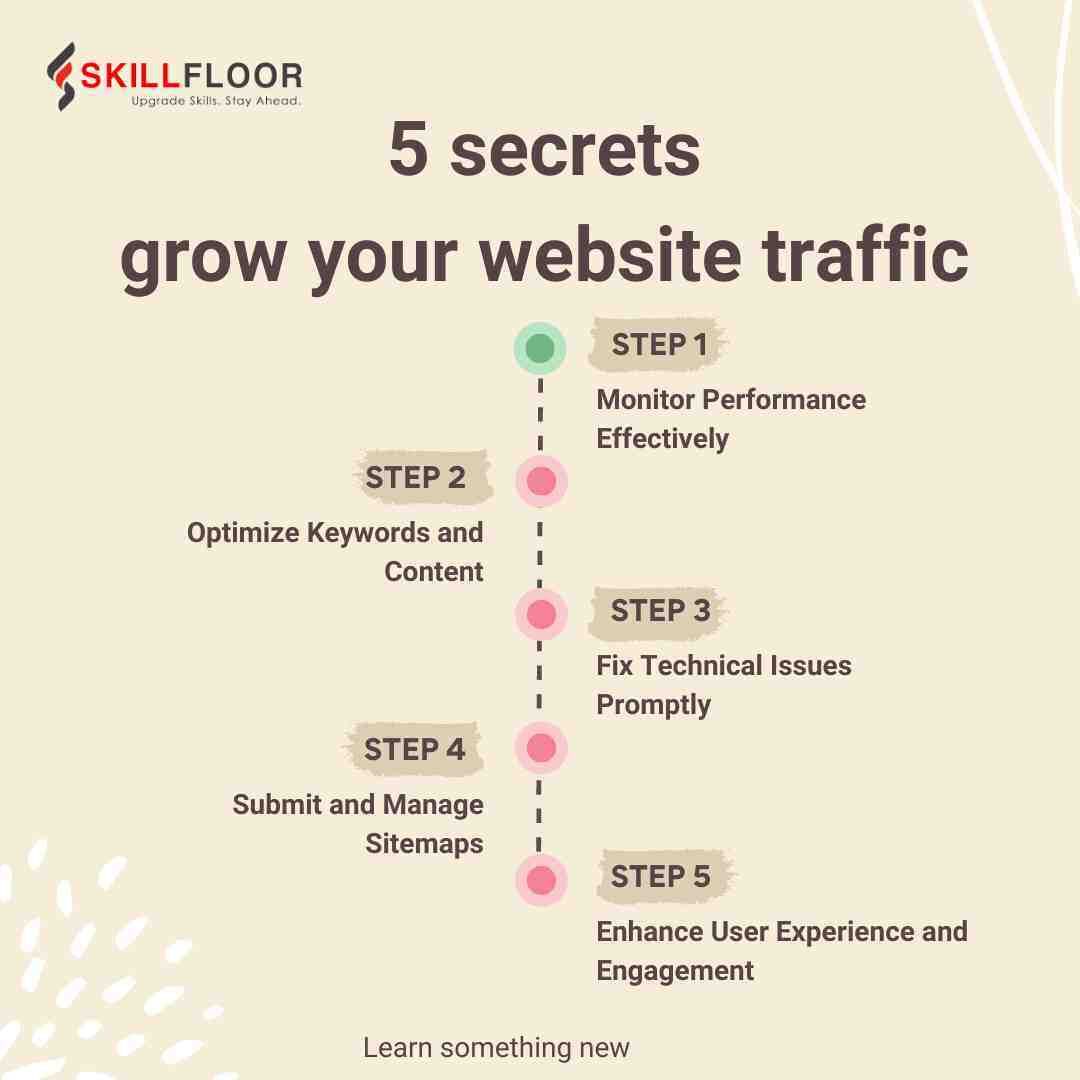Tips to grow your website traffic with Search console
Learn essential strategies to increase website traffic using Google Search Console. Discover actionable tips and insights for optimizing SEO .

Website traffic is crucial for online success because it drives visibility, engagement, and revenue. High traffic increases the chances of reaching potential customers, leading to more conversions and sales. It also boosts search engine rankings, making the site easier to find. Consistent traffic helps businesses understand their audience better, allowing for targeted marketing and content strategies. Moreover, advertisers are more likely to invest in sites with substantial traffic, providing additional revenue streams. Ultimately, website traffic is a fundamental metric that reflects a site’s popularity and effectiveness in attracting and retaining users.
Google Search Console is a powerful tool for improving website traffic by providing valuable insights and data about how your site performs in Google search results. It helps website owners monitor and troubleshoot their site's presence in search results, offering detailed reports on search traffic, search queries, and site errors. By understanding which keywords drive traffic, identifying high-performing pages, and resolving technical issues, Google Search Console enables users to optimize their content and improve their site's visibility. This, in turn, can lead to increased traffic, better user engagement, and higher search rankings, making it an essential tool for any online success strategy.
Understanding Search Console Basics
Google Search Console is a free tool provided by Google that helps website owners monitor, maintain, and troubleshoot their site's presence in Google search results. It offers valuable insights into how Google perceives your site, which keywords lead to your site appearing in search results, and how users interact with your site through search.
Key Features:
-
Performance Report: Provides data on how often your site appears in Google search results, which queries users are using to find your site, and the click-through rates (CTR) for those queries. This helps you understand which keywords are driving traffic to your site.
-
Sitemap Submission: Allows you to submit XML sitemaps, making it easier for Google to crawl and understand the structure of your site. This can improve the indexing of your pages and ensure they are included in search results.
-
Mobile Usability: Checks how mobile-friendly your site is and identifies any issues that could impact user experience on mobile devices. With mobile searches on the rise, ensuring a mobile-friendly site is crucial for retaining traffic.
-
Links: Shows which sites link to yours, helping you monitor your backlink profile. This can inform your link-building strategies and identify potential spammy links that could harm your site's ranking.
-
Core Web Vitals: Provides insights into your site's loading speed, interactivity, and visual stability – crucial factors for user experience and search engine rankings, especially with Google's emphasis on user-centric performance metrics.
Why it's Important:
Google Search Console empowers website owners and marketers to optimize their sites for better search engine visibility and user experience. By using the data and insights provided, you can identify opportunities for improvement, fix issues that could hinder your site's performance in search results, and ultimately increase organic traffic to your website. Understanding and utilizing Google Search Console effectively can significantly contribute to the overall success of your online presence.
complexities of SEO and traffic generation
SEO and generating website traffic can be complex due to how search engine algorithms work. Changes in these algorithms directly affect how well a website appears in search results. Here are some key impacts:
-
Ranking Changes: Algorithms updates can cause a website's ranking to fluctuate. A site that was ranking well may drop if it doesn't match the new criteria.
-
Algorithm Updates: Major updates, like Google's core updates, can completely change search results. They aim to improve relevance but can surprise website owners with unexpected drops or gains.
-
New Factors: Search engines continually add new factors like mobile-friendliness and page speed. Websites need to keep up to stay visible.
-
Penalties: Breaking search engine rules can lead to penalties, reducing a site's visibility or even removing it from search results.
-
Competitors: Changes also affect how competitors rank, influencing traffic levels.
To navigate these challenges, staying updated with algorithm changes, monitoring performance, and focusing on quality content are essential for maintaining and growing website traffic.
How can businesses effectively use Search Console to boost website traffic?
5 Steps businesses effectively use Search Console to boost website traffic

-
Monitor Performance Effectively:
-
Utilize the Performance Report: Regularly review the Performance report in Google Search Console to gain insights into how your website is performing in Google search results. This report provides valuable data on key metrics such as clicks, impressions, click-through rates (CTR), and average position for various queries and pages.
-
Identify High-Performing Content: Analyze the data to identify pages that receive high impressions but low clicks. This indicates opportunities to improve meta titles, meta descriptions, and content to make them more compelling and clickable.
-
Spot Trends and Seasonality: Use the time frame comparison feature to identify trends and seasonality in search traffic. Adjust your content and marketing strategies accordingly to capitalize on peak periods and address any declines.
-
Optimize Keywords and Content:
-
Search Queries Analysis: Dive into the Search Queries report to understand which keywords and phrases are driving traffic to your site. Identify high-performing keywords where your site ranks well and consider expanding content around these topics to capture more search traffic.
-
Content Gap Analysis: Look for queries where your site appears in search results but has a low CTR. Optimize meta tags and content to better match user intent and improve CTR.
-
Create New Content: Identify relevant search queries that your site currently does not address. Develop new content or expand existing pages to cover these topics comprehensively, enhancing your site's relevance and attracting more targeted traffic.
-
Fix Technical Issues Promptly:
-
Coverage and Indexing: Regularly check the Coverage report to identify and resolve any technical issues that could impact your site's visibility in search results. Address crawl errors, indexation problems, and issues with canonical tags or redirects promptly to ensure all important pages are properly indexed.
-
Mobile Usability: Monitor the Mobile Usability report to ensure your site is mobile-friendly. Google prioritizes mobile-friendly sites in mobile search results, so addressing usability issues on mobile devices can improve rankings and attract more mobile traffic.
-
Submit and Manage Sitemaps:
-
Sitemap Submission: Submit XML sitemaps to Google Search Console to help Google discover and crawl your site's pages more efficiently. Ensure your sitemaps are up to date and include all relevant URLs, including new pages and updates.
-
Monitor Indexing Status: Use the Index Coverage report to monitor the status of indexed pages. Check for any pages that are excluded from indexing and investigate the reasons behind it. Address issues such as duplicate content, thin content, or noindex tags to maximize the number of indexed pages.
-
Enhance User Experience and Engagement:
-
Behavioural Metrics Analysis: Use behavioural metrics such as bounce rate, average session duration, and pages per session to gauge user engagement on your site. Identify pages with high bounce rates and low engagement metrics, then optimize these pages to improve user experience and encourage visitors to explore more content.
-
Page Speed Insights: Monitor the Core Web Vitals report and PageSpeed Insights integration within Search Console to assess your site's loading speed and performance. Improve page speed by optimizing images, leveraging browser caching, and minimizing unnecessary scripts to enhance user experience and reduce bounce rates.
By implementing these strategies and leveraging the insights provided by Google Search Console, businesses can optimize their websites for better search engine visibility, attract more relevant traffic, and ultimately achieve their online marketing goals more effectively. Regularly monitoring performance, addressing technical issues promptly, and focusing on user experience improvements are key to sustaining and growing website traffic over time.
leveraging Google Search Console effectively can significantly enhance a website's visibility and traffic. By regularly monitoring performance metrics, identifying high-performing content, optimizing keywords and technical aspects, and enhancing user experience, businesses can navigate the complexities of SEO and algorithm changes more adeptly. These strategies not only boost organic search rankings but also improve user engagement, ultimately driving sustained growth and achieving online marketing objectives. Embracing Search Console as a pivotal tool empowers businesses to stay competitive in the dynamic digital landscape, ensuring continuous optimization and success in attracting and retaining valuable website traffic.




























































